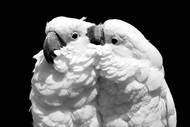Umbrella Cockatoo Fact Sheet
Posted by Umbrella Cockatoo facts, Cockatoo facts, what to feed an Umbrella Cockatoo, caring for an Umbrella Cockatoo on 9/1/2024
Rosemary Low has written this article with lots of interesting facts about the Umbrella Cockatoo.
Scientific name:
Cacatua alba
Common names:
White-crested Cockatoo, White Cockatoo
Adult length:
approx 18in (46cm)
Adult wingspan:
35in (88cm)
For everything an Umbrella Cockatoo needs please click here.
Adult weight:
approx. 500g
Potential lifespan:
60 years

Origin:
The northern Moluccas Islands of Indonesia such as Halmahera, Ternate and Batjan.
Status in wild:
Classified as Vulnerable. A massive decline started during the 1980s due to large-scale trapping, also logging. Many of the tall trees necessary for nesting were removed. Habitat has been cleared for agriculture and for mining.
Trade:
Trapping continued at a very high level until 1999 when capture was made illegal. However, trapping still occurs and the population continues to decline. According to BirdLife International, in 1991 an estimated minimum of 6,600 birds (possibly representing a mere quarter of the real total) were taken from the wild.
Catch quotas for the species were exceeded up to 18 times in some localities. Up to 17% of the population was removed annually from some areas.
The tragedy of over-trapping
Over-trapping occurred to make money for the middle men ? not the trappers. The numbers caught far exceeded demand and the number of people able to give these birds a caring home.
Most purchasers had no idea of the difficulties involved in keeping an Umbrella Cockatoo as a companion bird.
Today these birds are still paying the price, with rescue centres full of Umbrella (and Moluccan) Cockatoos for whom suitable homes are impossible to find.
Sexing:
Iris dark brown in male, reddish-brown in female. Young birds have the iris brownish-grey.
Suitability:
A friend has a most wonderful Umbrella Cockatoo that can be taken anywhere and immediately starts to show off, will allow anyone to touch it and has an enchanting personality.
Rare birds like this have give rise to the notion that these Cockatoos make good pets. It is a fallacy. Most don?t ? often the owner?s fault because they have completely misunderstood the needs of such an intelligent and sentient bird.
Even the best carers find Umbrella Cockatoos extremely loud, expensively destructive and impossibly demanding in the home.
Hand-reared young are often the subject of impulse buying because they look so incredibly soft and cuddly.
Those unwise enough to resist the impulse to buy, be warned!
Umbrella Cockatoos are not properly weaned until they are 16 or 17 weeks old. Do not buy them at an earlier age.
Weaning:
If bought age unknown, continue to spoon-feed them with a reliable Parrot rearing food until they lose interest in being spoon-fed. So often I have heard the advice: ?Don?t feed them. You are making a rod for your own back.?
The truth is that many young Cockatoos sold as weaned die of starvation because they are unable to eat on their own. The weaning process must be extremely gradual, progressing from soft foods to seed at a slow pace, because Cockatoos (except Galah and Bare-eyed) take longer to wean than any other Parrots.
Offer those that are starting to nibble at foods (before they are even fully feathered) soft wholegrain bread, tender pieces of corn on the cob, cooked peas and beans, soaked (well rinsed) sunflower seed, par-boiled carrot, orange and green leaves such as spinach.
Spray millet can also be offered.
Note that parent-reared young are far more mature in their behaviour and vocalisations, whereas those that have been hand-reared exhibit the juvenile food-begging posture and calls for months.
Adult diet
The basic diet should consist of seed, cooked or sprouted beans and fresh fruits and vegetables. The seed mixture should include plenty of small seeds such as canary, white millet, safflower, oats and a little hemp, to help keep them occupied.Corn on the cob and peas in the pod are favourites.
During cold weather, warm cooked peas are relished. Umbrellas enjoy eating foods that can be held in the foot, including walnuts. All fruits can be offered, also dry biscuits (unsalted) and small cubes of cheese.
Click here for the best Cockatoo food.
For more information read Rosemary Low?s book Cockatoos in Aviculture.
Click here for everything an Umbrella Cockatoo needs.




